The Impact of US Withdrawal from the Trans-Pacific Partnership
VerifiedAdded on 2020/05/11
|9
|1833
|94
Report
AI Summary
This report investigates the economic implications of the Trans-Pacific Partnership (TPP) in the absence of the United States. It examines the effects on US consumers and producers, as well as those in the 11 non-US member countries, considering impacts on trade, tariffs, and the elasticity of demand and supply in the agricultural industries. The analysis delves into the consequences of US withdrawal on global efficiency, trade deficits, and the potential for the US to eliminate its trade deficit through imposing trade restrictions. The report concludes with a synthesis of the likely economic repercussions of the US decision to withdraw from the TPP, highlighting both the benefits and drawbacks for various stakeholders and the global economy.
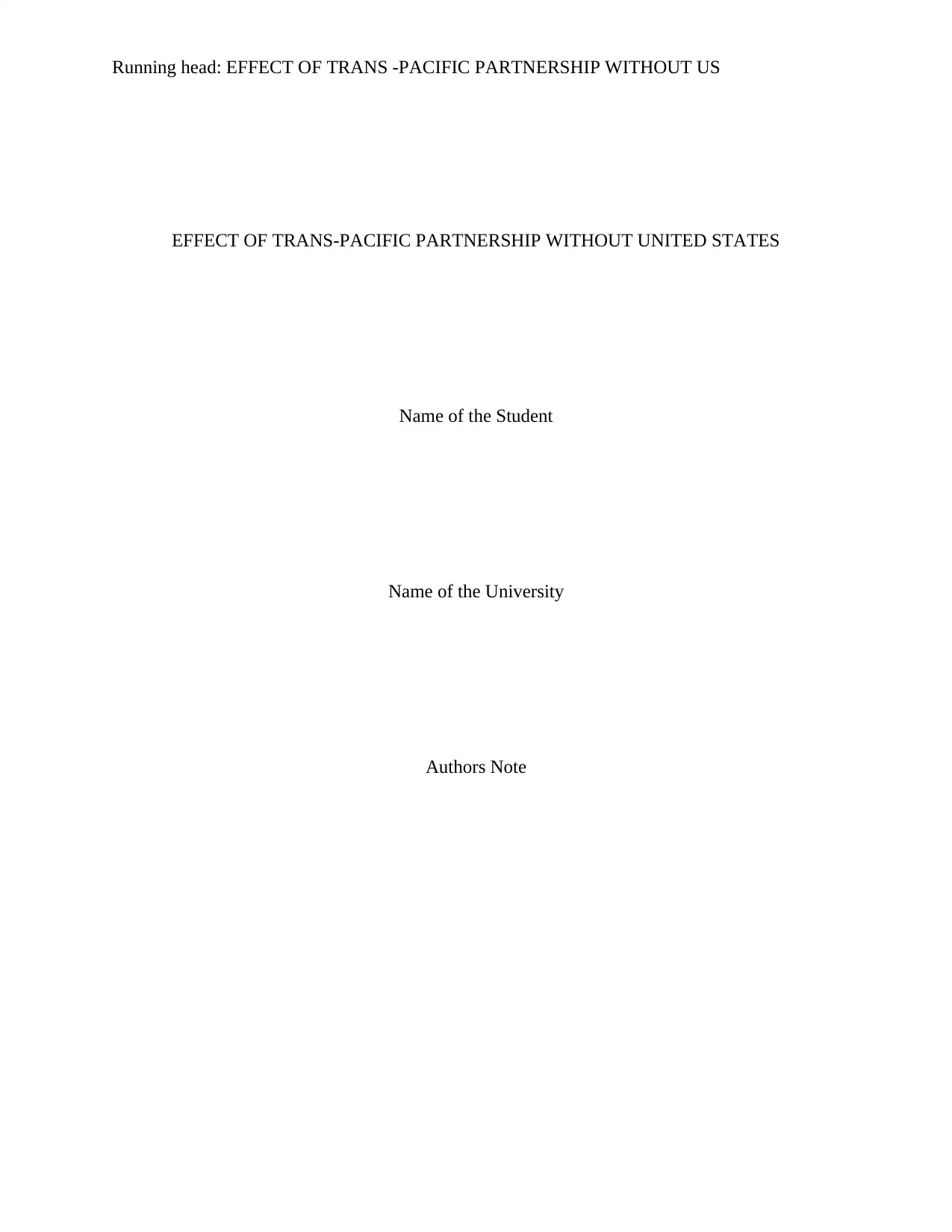
Running head: EFFECT OF TRANS -PACIFIC PARTNERSHIP WITHOUT US
EFFECT OF TRANS-PACIFIC PARTNERSHIP WITHOUT UNITED STATES
Name of the Student
Name of the University
Authors Note
EFFECT OF TRANS-PACIFIC PARTNERSHIP WITHOUT UNITED STATES
Name of the Student
Name of the University
Authors Note
Paraphrase This Document
Need a fresh take? Get an instant paraphrase of this document with our AI Paraphraser
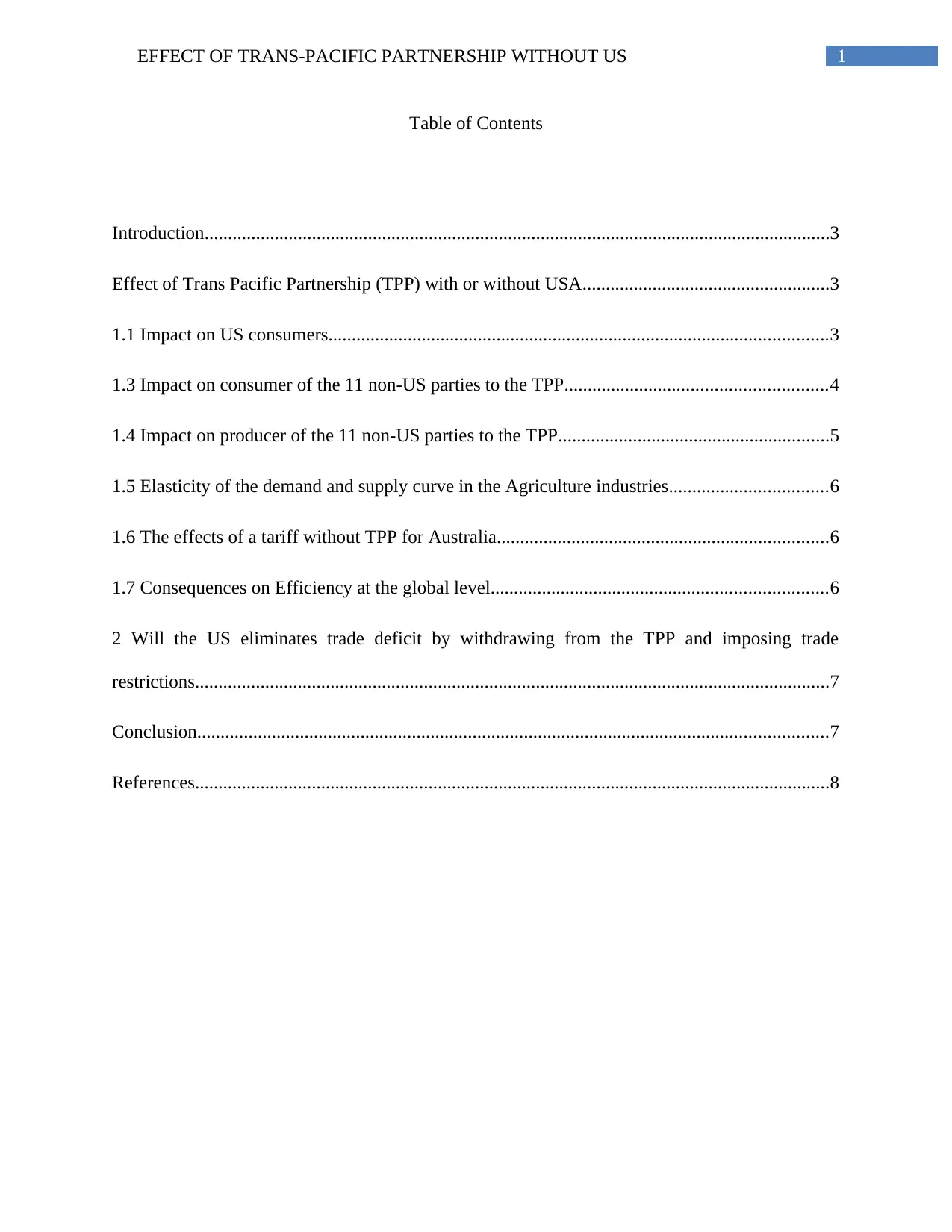
1EFFECT OF TRANS-PACIFIC PARTNERSHIP WITHOUT US
Table of Contents
Introduction......................................................................................................................................3
Effect of Trans Pacific Partnership (TPP) with or without USA.....................................................3
1.1 Impact on US consumers...........................................................................................................3
1.3 Impact on consumer of the 11 non-US parties to the TPP........................................................4
1.4 Impact on producer of the 11 non-US parties to the TPP..........................................................5
1.5 Elasticity of the demand and supply curve in the Agriculture industries..................................6
1.6 The effects of a tariff without TPP for Australia.......................................................................6
1.7 Consequences on Efficiency at the global level........................................................................6
2 Will the US eliminates trade deficit by withdrawing from the TPP and imposing trade
restrictions........................................................................................................................................7
Conclusion.......................................................................................................................................7
References........................................................................................................................................8
Table of Contents
Introduction......................................................................................................................................3
Effect of Trans Pacific Partnership (TPP) with or without USA.....................................................3
1.1 Impact on US consumers...........................................................................................................3
1.3 Impact on consumer of the 11 non-US parties to the TPP........................................................4
1.4 Impact on producer of the 11 non-US parties to the TPP..........................................................5
1.5 Elasticity of the demand and supply curve in the Agriculture industries..................................6
1.6 The effects of a tariff without TPP for Australia.......................................................................6
1.7 Consequences on Efficiency at the global level........................................................................6
2 Will the US eliminates trade deficit by withdrawing from the TPP and imposing trade
restrictions........................................................................................................................................7
Conclusion.......................................................................................................................................7
References........................................................................................................................................8
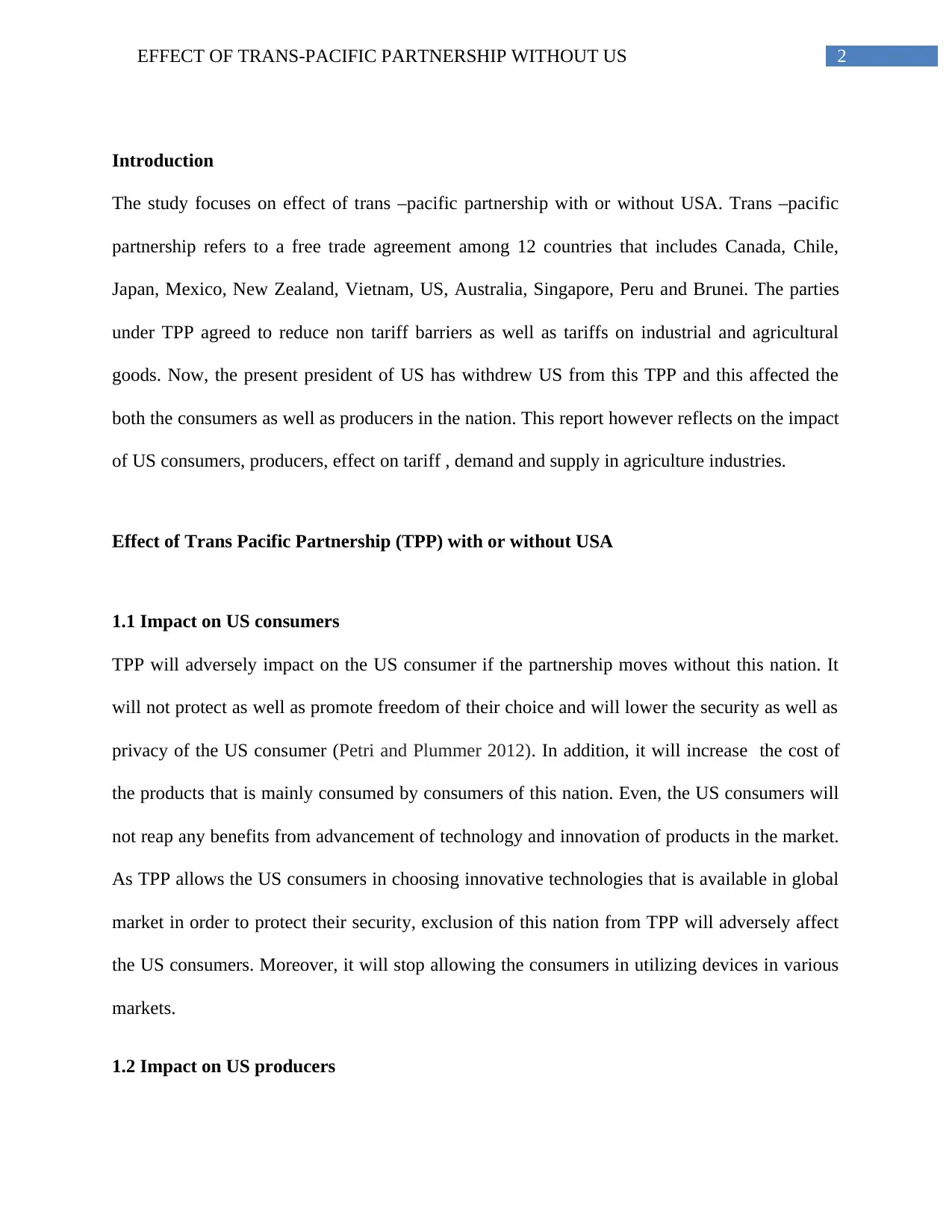
2EFFECT OF TRANS-PACIFIC PARTNERSHIP WITHOUT US
Introduction
The study focuses on effect of trans –pacific partnership with or without USA. Trans –pacific
partnership refers to a free trade agreement among 12 countries that includes Canada, Chile,
Japan, Mexico, New Zealand, Vietnam, US, Australia, Singapore, Peru and Brunei. The parties
under TPP agreed to reduce non tariff barriers as well as tariffs on industrial and agricultural
goods. Now, the present president of US has withdrew US from this TPP and this affected the
both the consumers as well as producers in the nation. This report however reflects on the impact
of US consumers, producers, effect on tariff , demand and supply in agriculture industries.
Effect of Trans Pacific Partnership (TPP) with or without USA
1.1 Impact on US consumers
TPP will adversely impact on the US consumer if the partnership moves without this nation. It
will not protect as well as promote freedom of their choice and will lower the security as well as
privacy of the US consumer (Petri and Plummer 2012). In addition, it will increase the cost of
the products that is mainly consumed by consumers of this nation. Even, the US consumers will
not reap any benefits from advancement of technology and innovation of products in the market.
As TPP allows the US consumers in choosing innovative technologies that is available in global
market in order to protect their security, exclusion of this nation from TPP will adversely affect
the US consumers. Moreover, it will stop allowing the consumers in utilizing devices in various
markets.
1.2 Impact on US producers
Introduction
The study focuses on effect of trans –pacific partnership with or without USA. Trans –pacific
partnership refers to a free trade agreement among 12 countries that includes Canada, Chile,
Japan, Mexico, New Zealand, Vietnam, US, Australia, Singapore, Peru and Brunei. The parties
under TPP agreed to reduce non tariff barriers as well as tariffs on industrial and agricultural
goods. Now, the present president of US has withdrew US from this TPP and this affected the
both the consumers as well as producers in the nation. This report however reflects on the impact
of US consumers, producers, effect on tariff , demand and supply in agriculture industries.
Effect of Trans Pacific Partnership (TPP) with or without USA
1.1 Impact on US consumers
TPP will adversely impact on the US consumer if the partnership moves without this nation. It
will not protect as well as promote freedom of their choice and will lower the security as well as
privacy of the US consumer (Petri and Plummer 2012). In addition, it will increase the cost of
the products that is mainly consumed by consumers of this nation. Even, the US consumers will
not reap any benefits from advancement of technology and innovation of products in the market.
As TPP allows the US consumers in choosing innovative technologies that is available in global
market in order to protect their security, exclusion of this nation from TPP will adversely affect
the US consumers. Moreover, it will stop allowing the consumers in utilizing devices in various
markets.
1.2 Impact on US producers
⊘ This is a preview!⊘
Do you want full access?
Subscribe today to unlock all pages.

Trusted by 1+ million students worldwide
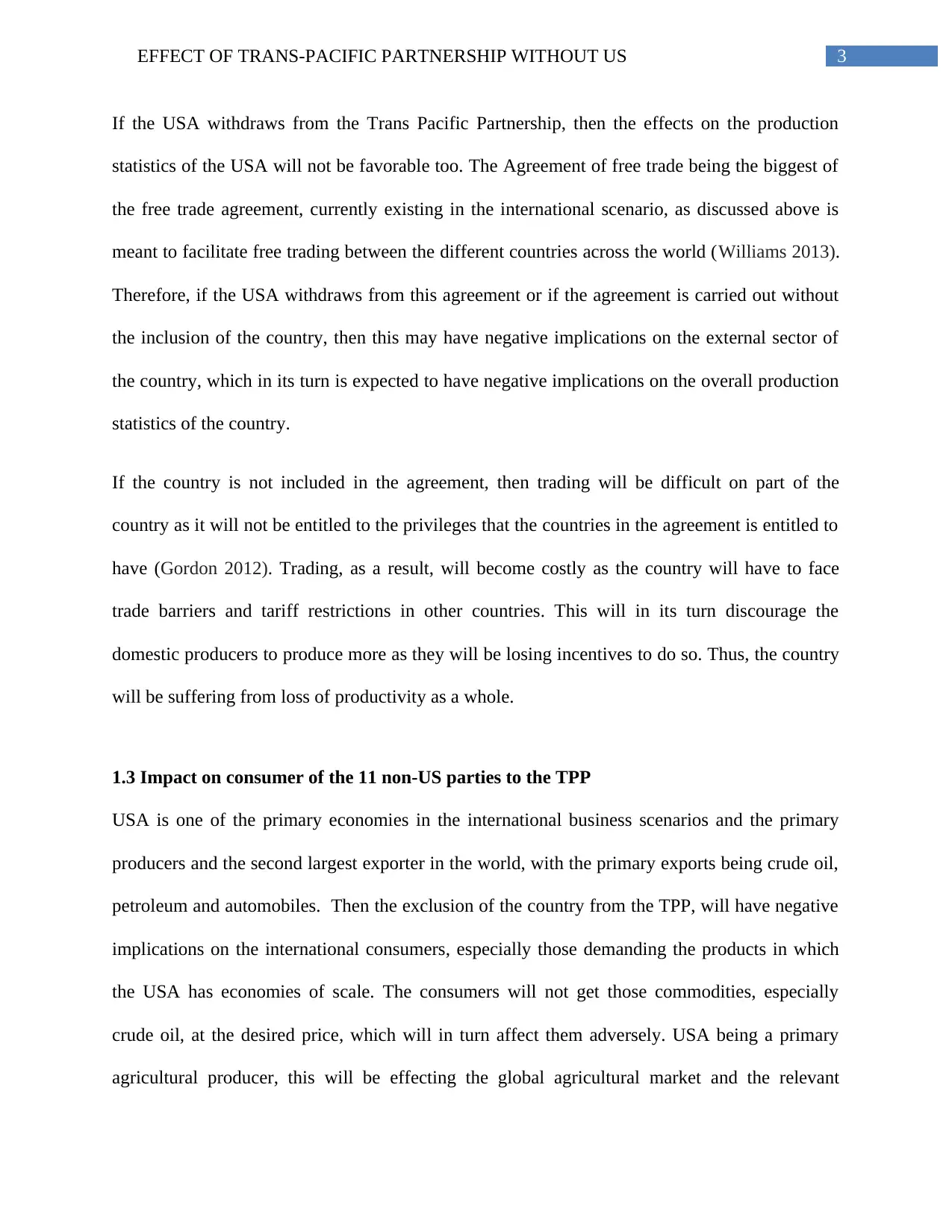
3EFFECT OF TRANS-PACIFIC PARTNERSHIP WITHOUT US
If the USA withdraws from the Trans Pacific Partnership, then the effects on the production
statistics of the USA will not be favorable too. The Agreement of free trade being the biggest of
the free trade agreement, currently existing in the international scenario, as discussed above is
meant to facilitate free trading between the different countries across the world (Williams 2013).
Therefore, if the USA withdraws from this agreement or if the agreement is carried out without
the inclusion of the country, then this may have negative implications on the external sector of
the country, which in its turn is expected to have negative implications on the overall production
statistics of the country.
If the country is not included in the agreement, then trading will be difficult on part of the
country as it will not be entitled to the privileges that the countries in the agreement is entitled to
have (Gordon 2012). Trading, as a result, will become costly as the country will have to face
trade barriers and tariff restrictions in other countries. This will in its turn discourage the
domestic producers to produce more as they will be losing incentives to do so. Thus, the country
will be suffering from loss of productivity as a whole.
1.3 Impact on consumer of the 11 non-US parties to the TPP
USA is one of the primary economies in the international business scenarios and the primary
producers and the second largest exporter in the world, with the primary exports being crude oil,
petroleum and automobiles. Then the exclusion of the country from the TPP, will have negative
implications on the international consumers, especially those demanding the products in which
the USA has economies of scale. The consumers will not get those commodities, especially
crude oil, at the desired price, which will in turn affect them adversely. USA being a primary
agricultural producer, this will be effecting the global agricultural market and the relevant
If the USA withdraws from the Trans Pacific Partnership, then the effects on the production
statistics of the USA will not be favorable too. The Agreement of free trade being the biggest of
the free trade agreement, currently existing in the international scenario, as discussed above is
meant to facilitate free trading between the different countries across the world (Williams 2013).
Therefore, if the USA withdraws from this agreement or if the agreement is carried out without
the inclusion of the country, then this may have negative implications on the external sector of
the country, which in its turn is expected to have negative implications on the overall production
statistics of the country.
If the country is not included in the agreement, then trading will be difficult on part of the
country as it will not be entitled to the privileges that the countries in the agreement is entitled to
have (Gordon 2012). Trading, as a result, will become costly as the country will have to face
trade barriers and tariff restrictions in other countries. This will in its turn discourage the
domestic producers to produce more as they will be losing incentives to do so. Thus, the country
will be suffering from loss of productivity as a whole.
1.3 Impact on consumer of the 11 non-US parties to the TPP
USA is one of the primary economies in the international business scenarios and the primary
producers and the second largest exporter in the world, with the primary exports being crude oil,
petroleum and automobiles. Then the exclusion of the country from the TPP, will have negative
implications on the international consumers, especially those demanding the products in which
the USA has economies of scale. The consumers will not get those commodities, especially
crude oil, at the desired price, which will in turn affect them adversely. USA being a primary
agricultural producer, this will be effecting the global agricultural market and the relevant
Paraphrase This Document
Need a fresh take? Get an instant paraphrase of this document with our AI Paraphraser
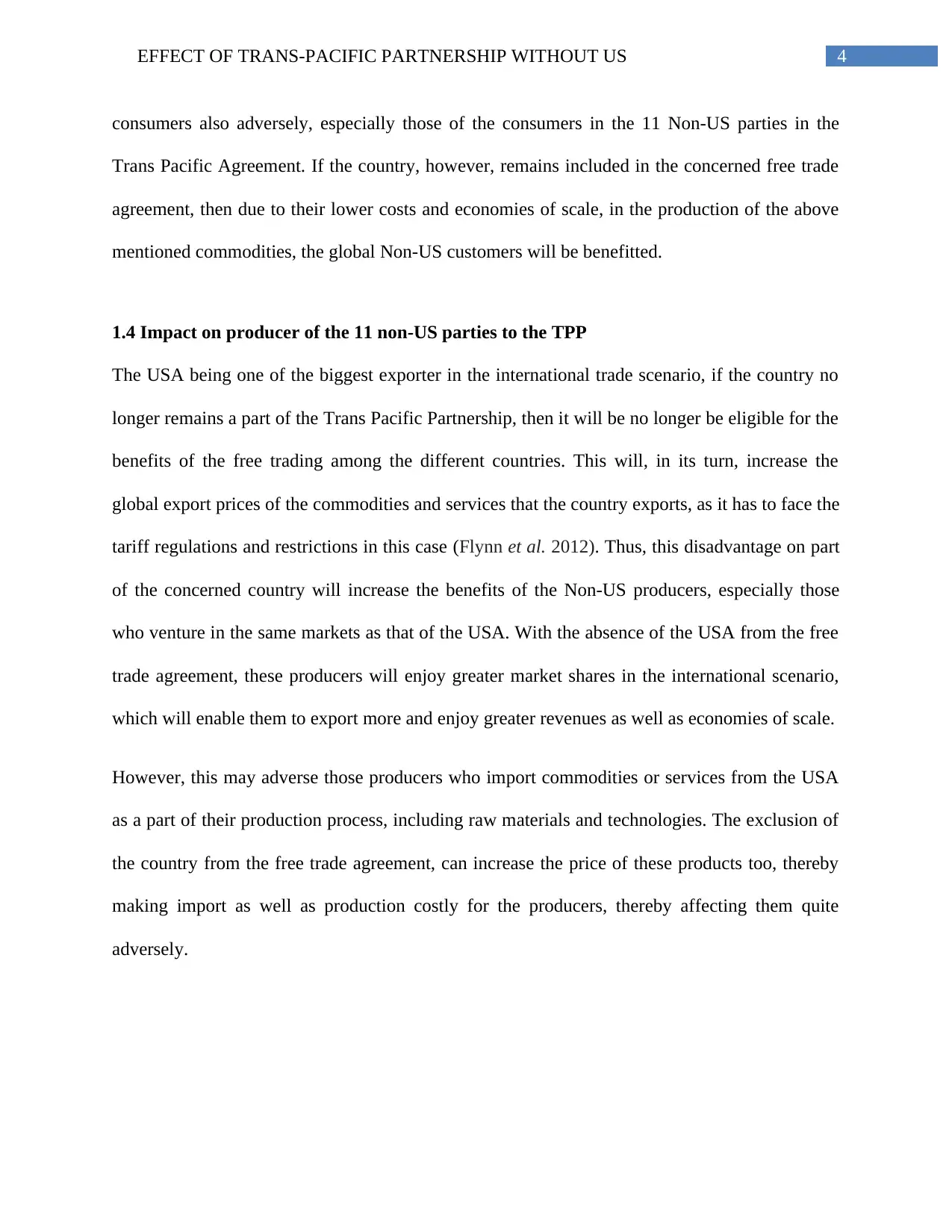
4EFFECT OF TRANS-PACIFIC PARTNERSHIP WITHOUT US
consumers also adversely, especially those of the consumers in the 11 Non-US parties in the
Trans Pacific Agreement. If the country, however, remains included in the concerned free trade
agreement, then due to their lower costs and economies of scale, in the production of the above
mentioned commodities, the global Non-US customers will be benefitted.
1.4 Impact on producer of the 11 non-US parties to the TPP
The USA being one of the biggest exporter in the international trade scenario, if the country no
longer remains a part of the Trans Pacific Partnership, then it will be no longer be eligible for the
benefits of the free trading among the different countries. This will, in its turn, increase the
global export prices of the commodities and services that the country exports, as it has to face the
tariff regulations and restrictions in this case (Flynn et al. 2012). Thus, this disadvantage on part
of the concerned country will increase the benefits of the Non-US producers, especially those
who venture in the same markets as that of the USA. With the absence of the USA from the free
trade agreement, these producers will enjoy greater market shares in the international scenario,
which will enable them to export more and enjoy greater revenues as well as economies of scale.
However, this may adverse those producers who import commodities or services from the USA
as a part of their production process, including raw materials and technologies. The exclusion of
the country from the free trade agreement, can increase the price of these products too, thereby
making import as well as production costly for the producers, thereby affecting them quite
adversely.
consumers also adversely, especially those of the consumers in the 11 Non-US parties in the
Trans Pacific Agreement. If the country, however, remains included in the concerned free trade
agreement, then due to their lower costs and economies of scale, in the production of the above
mentioned commodities, the global Non-US customers will be benefitted.
1.4 Impact on producer of the 11 non-US parties to the TPP
The USA being one of the biggest exporter in the international trade scenario, if the country no
longer remains a part of the Trans Pacific Partnership, then it will be no longer be eligible for the
benefits of the free trading among the different countries. This will, in its turn, increase the
global export prices of the commodities and services that the country exports, as it has to face the
tariff regulations and restrictions in this case (Flynn et al. 2012). Thus, this disadvantage on part
of the concerned country will increase the benefits of the Non-US producers, especially those
who venture in the same markets as that of the USA. With the absence of the USA from the free
trade agreement, these producers will enjoy greater market shares in the international scenario,
which will enable them to export more and enjoy greater revenues as well as economies of scale.
However, this may adverse those producers who import commodities or services from the USA
as a part of their production process, including raw materials and technologies. The exclusion of
the country from the free trade agreement, can increase the price of these products too, thereby
making import as well as production costly for the producers, thereby affecting them quite
adversely.
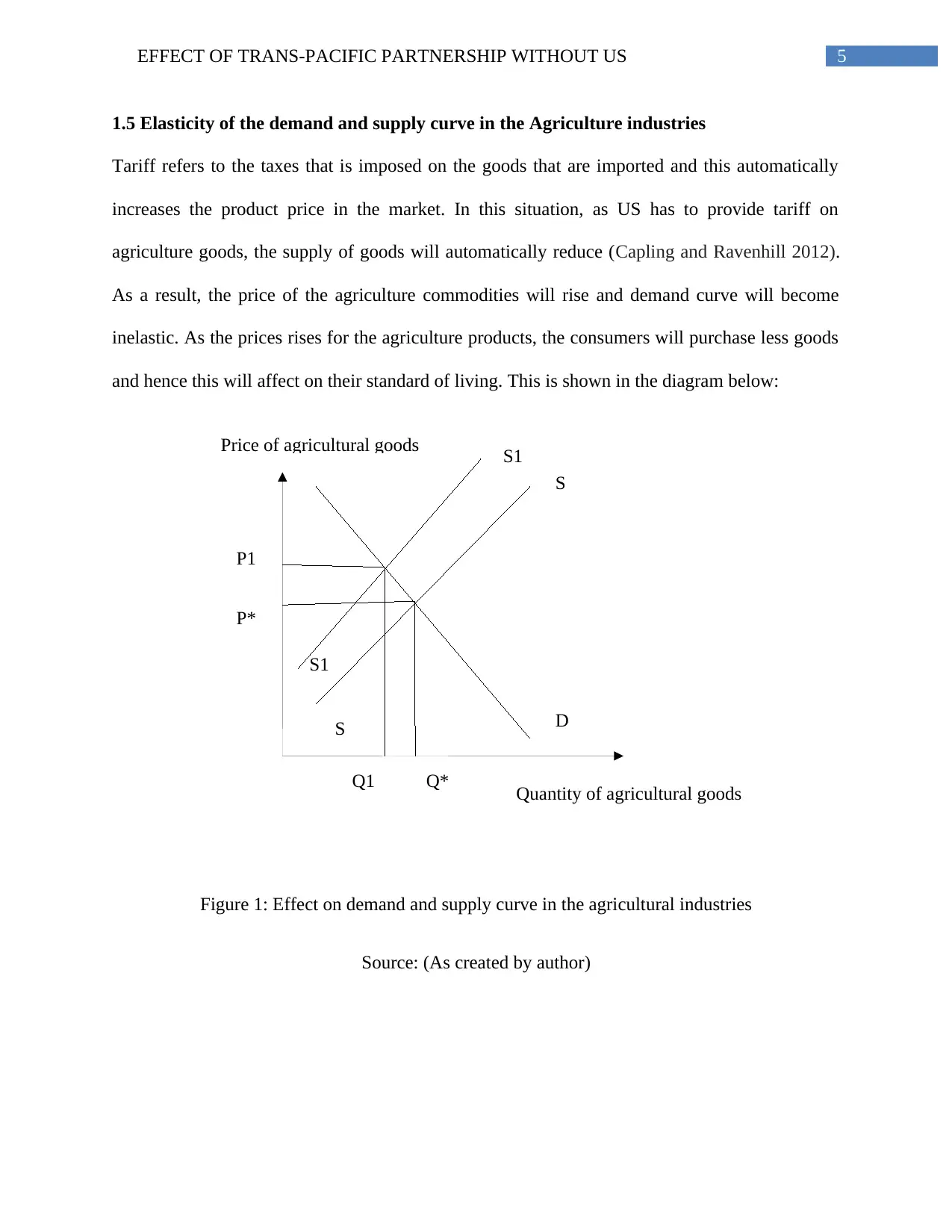
5EFFECT OF TRANS-PACIFIC PARTNERSHIP WITHOUT US
Quantity of agricultural goods
S
S1
S
S1
D
P*
Q*
P1
Q1
1.5 Elasticity of the demand and supply curve in the Agriculture industries
Tariff refers to the taxes that is imposed on the goods that are imported and this automatically
increases the product price in the market. In this situation, as US has to provide tariff on
agriculture goods, the supply of goods will automatically reduce (Capling and Ravenhill 2012).
As a result, the price of the agriculture commodities will rise and demand curve will become
inelastic. As the prices rises for the agriculture products, the consumers will purchase less goods
and hence this will affect on their standard of living. This is shown in the diagram below:
Figure 1: Effect on demand and supply curve in the agricultural industries
Source: (As created by author)
Price of agricultural goods
Quantity of agricultural goods
S
S1
S
S1
D
P*
Q*
P1
Q1
1.5 Elasticity of the demand and supply curve in the Agriculture industries
Tariff refers to the taxes that is imposed on the goods that are imported and this automatically
increases the product price in the market. In this situation, as US has to provide tariff on
agriculture goods, the supply of goods will automatically reduce (Capling and Ravenhill 2012).
As a result, the price of the agriculture commodities will rise and demand curve will become
inelastic. As the prices rises for the agriculture products, the consumers will purchase less goods
and hence this will affect on their standard of living. This is shown in the diagram below:
Figure 1: Effect on demand and supply curve in the agricultural industries
Source: (As created by author)
Price of agricultural goods
⊘ This is a preview!⊘
Do you want full access?
Subscribe today to unlock all pages.

Trusted by 1+ million students worldwide
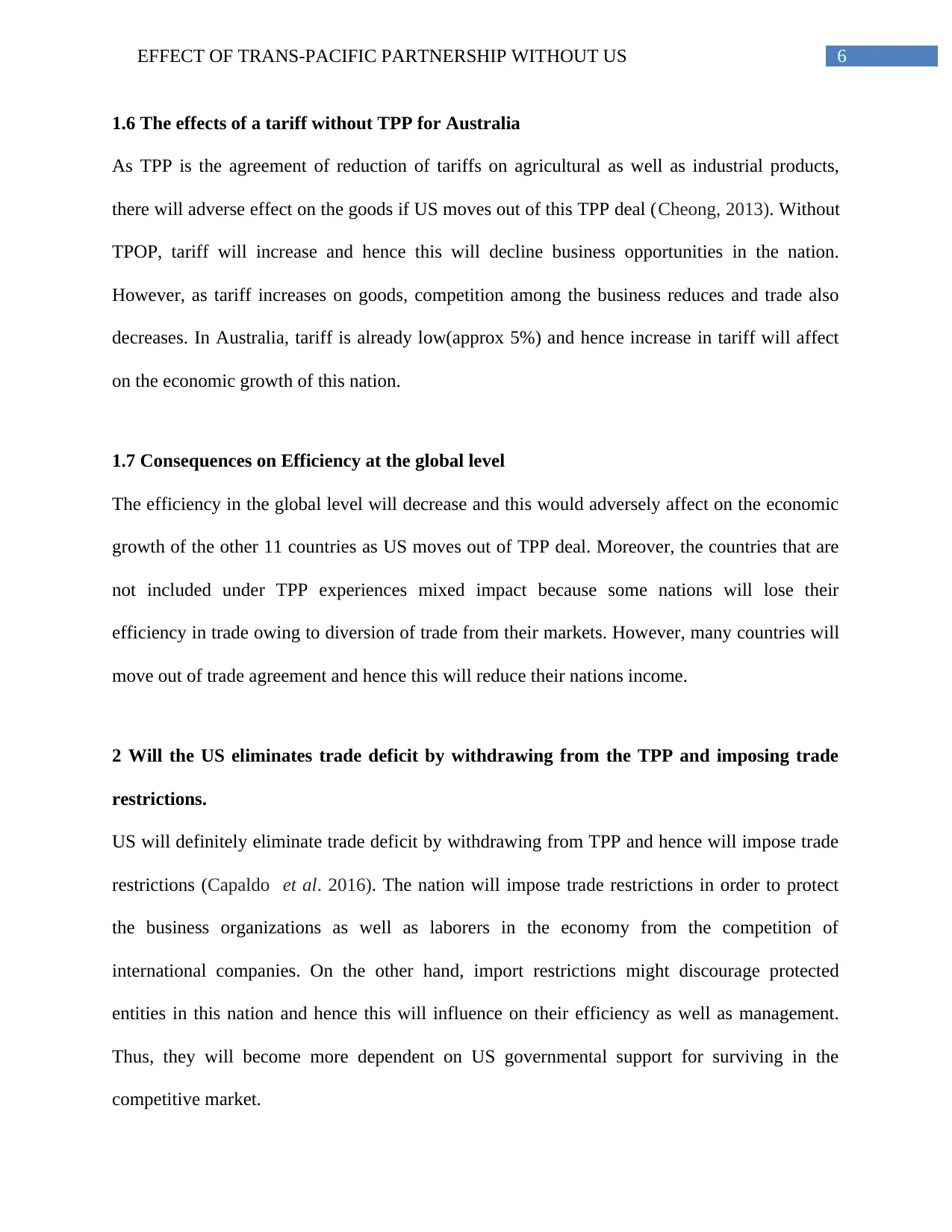
6EFFECT OF TRANS-PACIFIC PARTNERSHIP WITHOUT US
1.6 The effects of a tariff without TPP for Australia
As TPP is the agreement of reduction of tariffs on agricultural as well as industrial products,
there will adverse effect on the goods if US moves out of this TPP deal (Cheong, 2013). Without
TPOP, tariff will increase and hence this will decline business opportunities in the nation.
However, as tariff increases on goods, competition among the business reduces and trade also
decreases. In Australia, tariff is already low(approx 5%) and hence increase in tariff will affect
on the economic growth of this nation.
1.7 Consequences on Efficiency at the global level
The efficiency in the global level will decrease and this would adversely affect on the economic
growth of the other 11 countries as US moves out of TPP deal. Moreover, the countries that are
not included under TPP experiences mixed impact because some nations will lose their
efficiency in trade owing to diversion of trade from their markets. However, many countries will
move out of trade agreement and hence this will reduce their nations income.
2 Will the US eliminates trade deficit by withdrawing from the TPP and imposing trade
restrictions.
US will definitely eliminate trade deficit by withdrawing from TPP and hence will impose trade
restrictions (Capaldo et al. 2016). The nation will impose trade restrictions in order to protect
the business organizations as well as laborers in the economy from the competition of
international companies. On the other hand, import restrictions might discourage protected
entities in this nation and hence this will influence on their efficiency as well as management.
Thus, they will become more dependent on US governmental support for surviving in the
competitive market.
1.6 The effects of a tariff without TPP for Australia
As TPP is the agreement of reduction of tariffs on agricultural as well as industrial products,
there will adverse effect on the goods if US moves out of this TPP deal (Cheong, 2013). Without
TPOP, tariff will increase and hence this will decline business opportunities in the nation.
However, as tariff increases on goods, competition among the business reduces and trade also
decreases. In Australia, tariff is already low(approx 5%) and hence increase in tariff will affect
on the economic growth of this nation.
1.7 Consequences on Efficiency at the global level
The efficiency in the global level will decrease and this would adversely affect on the economic
growth of the other 11 countries as US moves out of TPP deal. Moreover, the countries that are
not included under TPP experiences mixed impact because some nations will lose their
efficiency in trade owing to diversion of trade from their markets. However, many countries will
move out of trade agreement and hence this will reduce their nations income.
2 Will the US eliminates trade deficit by withdrawing from the TPP and imposing trade
restrictions.
US will definitely eliminate trade deficit by withdrawing from TPP and hence will impose trade
restrictions (Capaldo et al. 2016). The nation will impose trade restrictions in order to protect
the business organizations as well as laborers in the economy from the competition of
international companies. On the other hand, import restrictions might discourage protected
entities in this nation and hence this will influence on their efficiency as well as management.
Thus, they will become more dependent on US governmental support for surviving in the
competitive market.
Paraphrase This Document
Need a fresh take? Get an instant paraphrase of this document with our AI Paraphraser

7EFFECT OF TRANS-PACIFIC PARTNERSHIP WITHOUT US
Conclusion
It can be concluded from the above assignment that if US president withdraws the nation from
the TPP deals, then this might adversely influence on their economic growth. Even other
countries will also be affected by this decision of the US president.
Conclusion
It can be concluded from the above assignment that if US president withdraws the nation from
the TPP deals, then this might adversely influence on their economic growth. Even other
countries will also be affected by this decision of the US president.
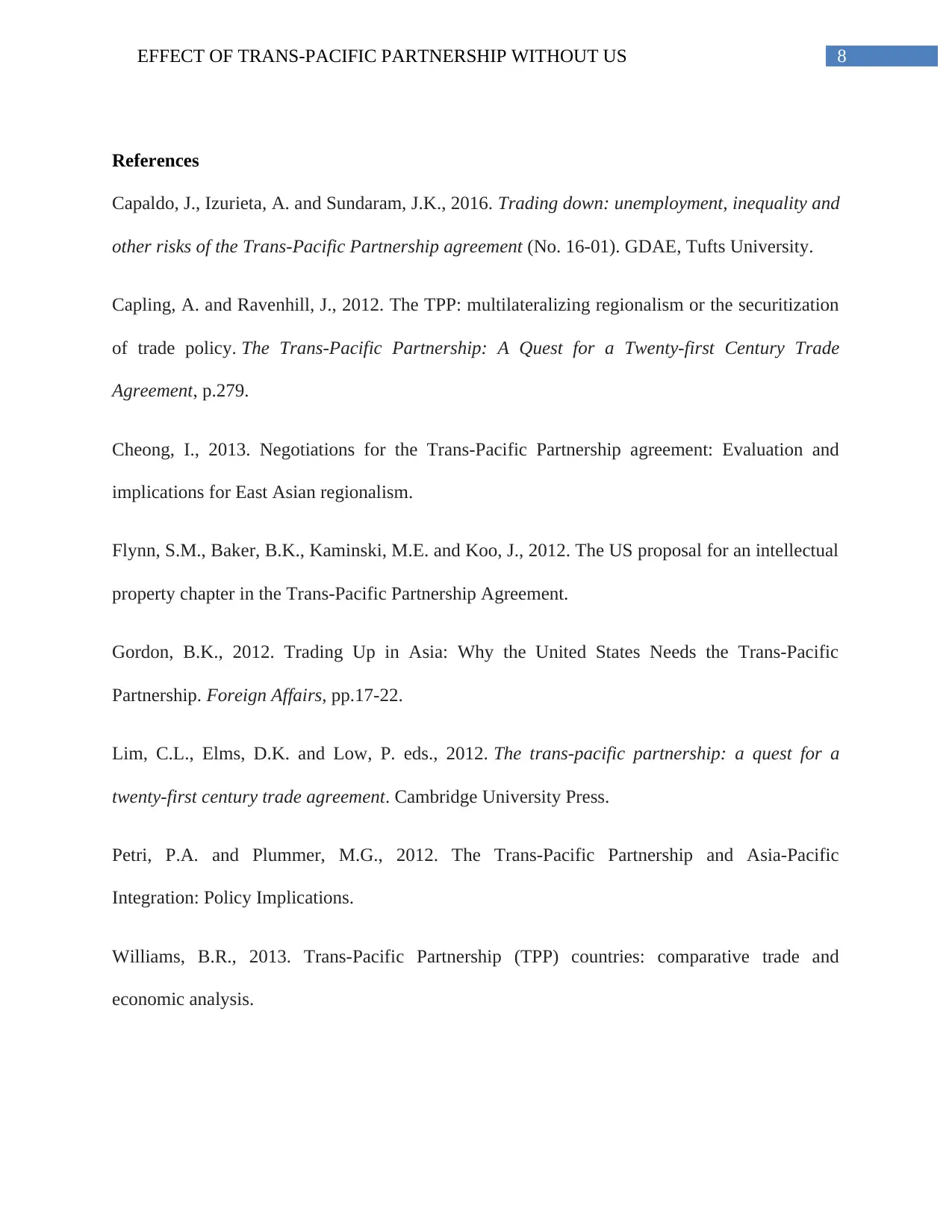
8EFFECT OF TRANS-PACIFIC PARTNERSHIP WITHOUT US
References
Capaldo, J., Izurieta, A. and Sundaram, J.K., 2016. Trading down: unemployment, inequality and
other risks of the Trans-Pacific Partnership agreement (No. 16-01). GDAE, Tufts University.
Capling, A. and Ravenhill, J., 2012. The TPP: multilateralizing regionalism or the securitization
of trade policy. The Trans-Pacific Partnership: A Quest for a Twenty-first Century Trade
Agreement, p.279.
Cheong, I., 2013. Negotiations for the Trans-Pacific Partnership agreement: Evaluation and
implications for East Asian regionalism.
Flynn, S.M., Baker, B.K., Kaminski, M.E. and Koo, J., 2012. The US proposal for an intellectual
property chapter in the Trans-Pacific Partnership Agreement.
Gordon, B.K., 2012. Trading Up in Asia: Why the United States Needs the Trans-Pacific
Partnership. Foreign Affairs, pp.17-22.
Lim, C.L., Elms, D.K. and Low, P. eds., 2012. The trans-pacific partnership: a quest for a
twenty-first century trade agreement. Cambridge University Press.
Petri, P.A. and Plummer, M.G., 2012. The Trans-Pacific Partnership and Asia-Pacific
Integration: Policy Implications.
Williams, B.R., 2013. Trans-Pacific Partnership (TPP) countries: comparative trade and
economic analysis.
References
Capaldo, J., Izurieta, A. and Sundaram, J.K., 2016. Trading down: unemployment, inequality and
other risks of the Trans-Pacific Partnership agreement (No. 16-01). GDAE, Tufts University.
Capling, A. and Ravenhill, J., 2012. The TPP: multilateralizing regionalism or the securitization
of trade policy. The Trans-Pacific Partnership: A Quest for a Twenty-first Century Trade
Agreement, p.279.
Cheong, I., 2013. Negotiations for the Trans-Pacific Partnership agreement: Evaluation and
implications for East Asian regionalism.
Flynn, S.M., Baker, B.K., Kaminski, M.E. and Koo, J., 2012. The US proposal for an intellectual
property chapter in the Trans-Pacific Partnership Agreement.
Gordon, B.K., 2012. Trading Up in Asia: Why the United States Needs the Trans-Pacific
Partnership. Foreign Affairs, pp.17-22.
Lim, C.L., Elms, D.K. and Low, P. eds., 2012. The trans-pacific partnership: a quest for a
twenty-first century trade agreement. Cambridge University Press.
Petri, P.A. and Plummer, M.G., 2012. The Trans-Pacific Partnership and Asia-Pacific
Integration: Policy Implications.
Williams, B.R., 2013. Trans-Pacific Partnership (TPP) countries: comparative trade and
economic analysis.
⊘ This is a preview!⊘
Do you want full access?
Subscribe today to unlock all pages.

Trusted by 1+ million students worldwide
1 out of 9
Related Documents
Your All-in-One AI-Powered Toolkit for Academic Success.
+13062052269
info@desklib.com
Available 24*7 on WhatsApp / Email
![[object Object]](/_next/static/media/star-bottom.7253800d.svg)
Unlock your academic potential
Copyright © 2020–2025 A2Z Services. All Rights Reserved. Developed and managed by ZUCOL.




